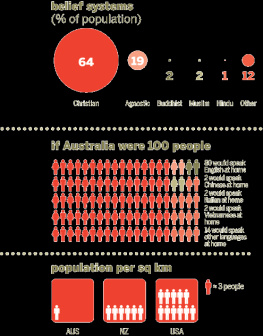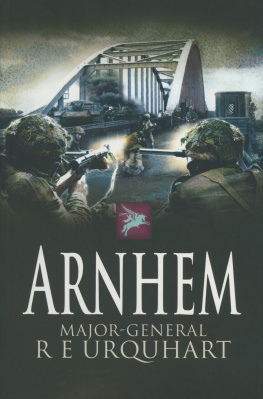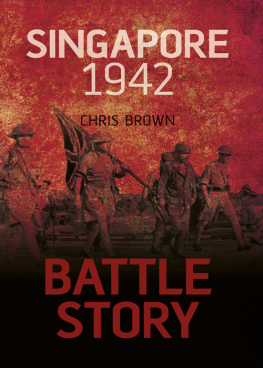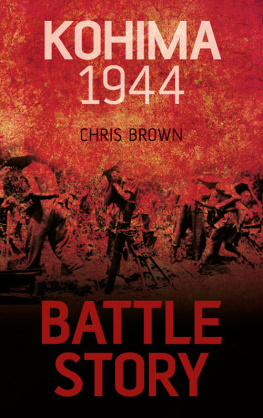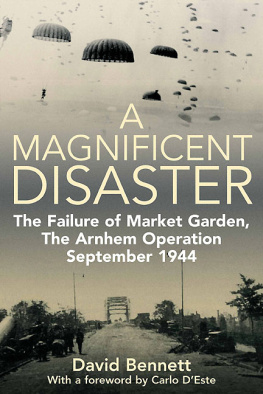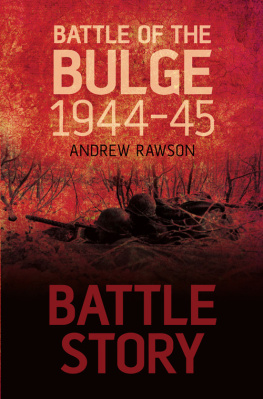
This book is dedicated to the memory of my late father-in-law, Robert Smith of Arran and to his dear friend James Laindon Jackson Cornwell, who died in Japanese captivity on or about 3 May 1943, aged twenty-two.
CONTENTS
The British
The Germans
The Strategy
Planning the Landings
The XXX Corps Plan
The Landings Commence
The Attack Commences Day One
Appraising the Situation Day Two
Opposition Increases Day Three
Waiting for Reinforcements Day Four
The Bridge is Lost Day Five
No Way Across Day Six
Under Fire Day Seven
Operation Berlin Day Eight
The Germans
As ever I am indebted to my wife and I am grateful for the patience of my children and their partners, Robert, Charis, Christopher, Colin, Alex, Juliet and Mariola and my dog Sam, all of whom have to listen to much more history than can possibly be reasonable. My grateful thanks also to the series editor, Jo de Vries, whose patience with writers is seemingly boundless and also to Ian Davidson of the Parachute and Glider Warfare Group and Mark Hickman at the Pegasus Archive for all their generous help with the photographs. Lloyd Clark kindly granted permission for use and adaptation of several maps from his excellent book, Arnhem:OperationMarketGarden,September1944 (Sutton/The History Press, 2002). Several photographs have also been used from the recent detailed study, OperationMarketGarden:LegendoftheWaalCrossing (The History Press, 2011), by kind permission of the author, Tim Lynch.
Unless otherwise credited all illustrations have been sourced from US and UK public domain sources.
1North-west Europe, 1944. (CourtesyofLloydClark, Arnhem)
2Elements of XXX Corps approaching the Meuse-Escaut Canal from the bridgehead at Neerpelt.
3Map of the Market Garden operation. (CourtesyofTimLynch)
4British officer armed only with a service revolver.
5Four of these American Waco gliders were assigned to the Arnhem operation to transport American air support control staff.
6General Urquhart outside his headquarters at the Hartenstein Hotel in Oosterbeek.
7British paratroops landing.
8A Bren Carrier being unloaded from a Hamilcar glider.
975mm Pack Howitzer of the 1st Light Regiment in action.
10Airspeed Horsa Horsa gliders, two have been split in the centre in order to remove jeeps or 6 pounder anti-tank guns.
11LZ Z, showing Hamilcar gliders.
12Men of 1st Battalion the Parachute Regiment in a C47 Dakota en route to Arnhem.
13A British Sherman at Nijmegen.
14General Wilhelm Bittrich. (CourtesyofBundesarchiv)
15German infantry moving along a ditch in the Arnhem area. (CourtesyofBundesarchiv)
16The Market Garden plan, September 1944. (CourtesyofLloydClark, Arnhem)
17Field Marshal Montgomery and Lieutenant General Horrocks. (CourtesyofTimLynch)
18101st Airborne inspecting broken glider in Holland.
19General Sosabowski of the Polish Parachute Brigade talking with General Browning.
20Tanks of XXX Corps en route to Arnhem passing crowds of enthusiastic Netherlanders.
21A Douglas C47 Dakota aircraft. (CourtesyofTimLynch)
221st Parachute Brigade descending on Drop Zone (DZ) X on the first day of the battle.
23The Arnhem Battlefield, 1719 September 1944. (CourtesyofLloydClark, Arnhem)
24The Hartenstein Hotel as seen from the tennis courts where German POWs were held. (Authorphotograph)
25A British M10 tank destroyer crossing a Bailey bridge.
26Landing Zone (LZ) Z covered with Horsa gliders.
27A unit of Guards Armoured Division at Valkenswaard on the first day of the battle.
28Brigadier P.H.W. Hicks.
29British Airborne troops dug-in behind a hedge.
30Arnhem bridge. (Authorphotograph)
31Known to the troops of the Airborne Division as The White House, the Hotel Dreyeroord was the scene of fierce combat through the middle and latter stages of the battle. (Authorphotograph)
32British Airborne troops carrying the unloved Sten gun on a patrol in the Oosterbeek area.
33Two British airborne soldiers one apparently wearing a signallers headset man a slit-trench among the redundant jeeps and trailers.
34Vickers guns of a British machine gun platoon.
351st Airlanding Regiment in action at Oosterbeek.
36Elements of XXX Corps held up on the exposed road to Arnhem.
37British casualties receiving attention from American Airborne medics on the road to Nijmegen.
38Airborne troops recovering supplies after a drop.
39Nijmegen Bridge.
40Oosterbeek parish church at the base of the perimeter. (Authorphotograph)
41Temporary grave of an unidentified British airborne soldier.
42Vehicles of XXX Corps crossing the bridge at Nijmegen.
43German troops on the march near Arnhem.
44War correspondents of the Airborne Division.
45Airborne medic at the temporary grave of Private Edmond of 1st Airlanding Reconnaissance Squadron.
46German troops in distinctive pea-dot camouflage kit taken prisoner early in the fighting.
47Transport and fuel shortages forced the German Army to requisition thousands of bicycles.
48German Pzkw or Panther tank.
49XXX Corps armour moving through Eindhoven.
50A platoon of British infantry perched precariously on a Sherman tank. (CourtesyofTimLynch)
51The British 17 pounder anti-tank gun. (CourtesyofTimLynch)
52A 6 pounder anti-tank gun moving toward Arnhem in the early stages of the operation.
53A Sherman tank at the entrance to the Airborne Museum, formerly the Hartentstein Hotel, Oosterbeek. (Authorphotograph)
Frontcover: The first drop of 1st Parachute Brigade at Drop Zone Z. (National Archives, USA)
The Market Garden operation, and particularly the battle that raged in and around Arnhem and Oosterbeek for nine days in September 1944, has attracted a remarkable amount of attention and a formidable amount of material has been published about it, by participants and by both popular and academic historians. There are many reasons why it has proved to be such a popular battle. It was an unparalleled event; by far the greatest airborne operation there had ever been. It was dramatic and innovative, and it captured the imagination of the public throughout Europe and the United States. It has that special aura of a romantic and, in a sense, glorious defeat.
Another reason that it has been of enduring interest is that it is very rare to be able to study a divisional battle in such isolation. The battle area is relatively small and can be studied on the ground to a worthwhile degree in a fairly short space of time. For anyone who has the opportunity to visit the city of Arnhem and town of Oosterbeek, I can thoroughly recommend Major John Waddys book ATouroftheBattlefieldsofArnhem, and also Major and Mrs Holts BattlefieldGuidetoOperationMarketGarden for those who wish to see the bigger picture of the campaign as a whole.
Although this book is focused on the struggle of the British 1st Airborne Division and the attached 1st Polish Parachute Brigade, it is important to remember that their fight was part of a much larger offensive; there would have been no strategic value in capturing what is now called the John Frost Bridge over the Lower Rhine without also gaining control of a chain of river crossings from Neerpelt to Nijmegen.
Next page





